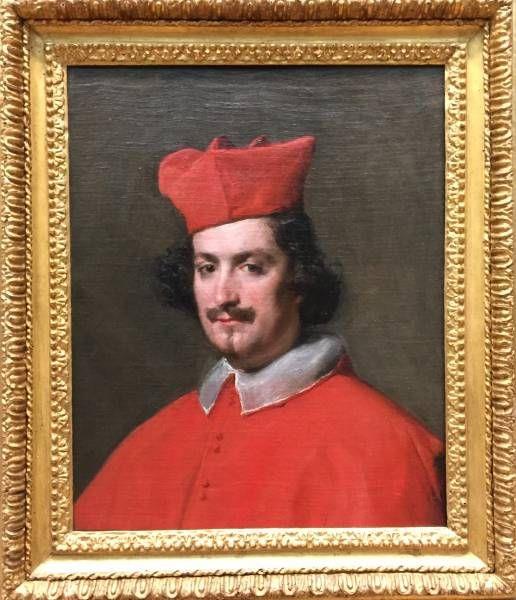Description
The work "Portrait of Cardinal Camillo Astali Pamphili", painted by Diego Velázquez in 1650, is a magnificent example of the artist's virtuosity and his ability to capture the essence of his subjects. In this work, Velázquez delves into the representation of ecclesiastical power through the figure of the cardinal, offering not only a physical portrait, but also a deep psychological exploration of the individual.
The composition presents the cardinal in a dignified and ceremonial pose. The central figure, in his rich attire, stands with a majestic bearing, radiating authority and respect. Velázquez has used a dark background that enhances the luminosity of the cardinal, who is dressed in exquisitely crafted clothing. The use of colors such as the crimson red of the cape and the gold details on the clothing reflect the wealth and status of the figure. This contrast between the somber background and the vibrant clothing is a distinctive feature of the painter's technique, which manages to highlight the main figure while maintaining a balanced sense of depth in the work.
The quality of the brushwork in this painting is spectacular. Velázquez, known for his innovative use of loose brushstrokes and his ability to capture the texture of different materials, makes his mastery evident here. Each fold of the canvas seems to come to life, and the light plays on the surfaces, giving an almost three-dimensional feel to the work. We see how the carefully oriented light not only highlights the cardinal's features, but also gives the composition a profound volatility, an effect that makes the viewer feel challenged by the gaze of the subject.
A fascinating aspect of the work is the way Velázquez manages to convey the Cardinal's personality through his facial expression. The Cardinal's serene and determined gaze, accompanied by a slight smile that suggests both wisdom and power, allows the viewer to glimpse both the strength of character and the humanity of the sitter. This duality of expression is a recurring feature in Velázquez's portraits, where he goes beyond simple physical representation to offer a more intimate view of the individual.
Diego Velázquez, who is considered one of the masters of the Spanish Baroque and a precursor of Impressionism, displays in this work his technical and emotional characteristics. Throughout his career, he was noted for his humanistic approach to portraiture, capturing the dignity and complexity of his subjects, which is evident in this portrait of the cardinal. Compared to other portraits of the period, "Portrait of Cardinal Camillo Astali Pamphili" maintains a distinction, not only for the elegance of the sitter, but for the deep perception that the artist offers about the figure of ecclesiastical power.
While little is known about the specific fate of this particular portrait after its creation, Velázquez’s influence can be seen in many subsequent portraits of prominent figures, which have sought to emulate the grandeur and emotional closeness that the master captured in his work. The way in which Velázquez articulates not only the representation of power, but also the intimacy and humanity of his subjects, marks a milestone in the history of portraiture and offers contemporary and future viewers deep insight into the figure portrayed, as well as the cultural context of his time.
KUADROS ©, a famous painting on your wall.
Hand-made oil painting reproductions, with the quality of professional artists and the distinctive seal of KUADROS ©.
Painting reproduction service with satisfaction guarantee. If you are not completely satisfied with the replica of your painting, we will refund 100% of your money.

